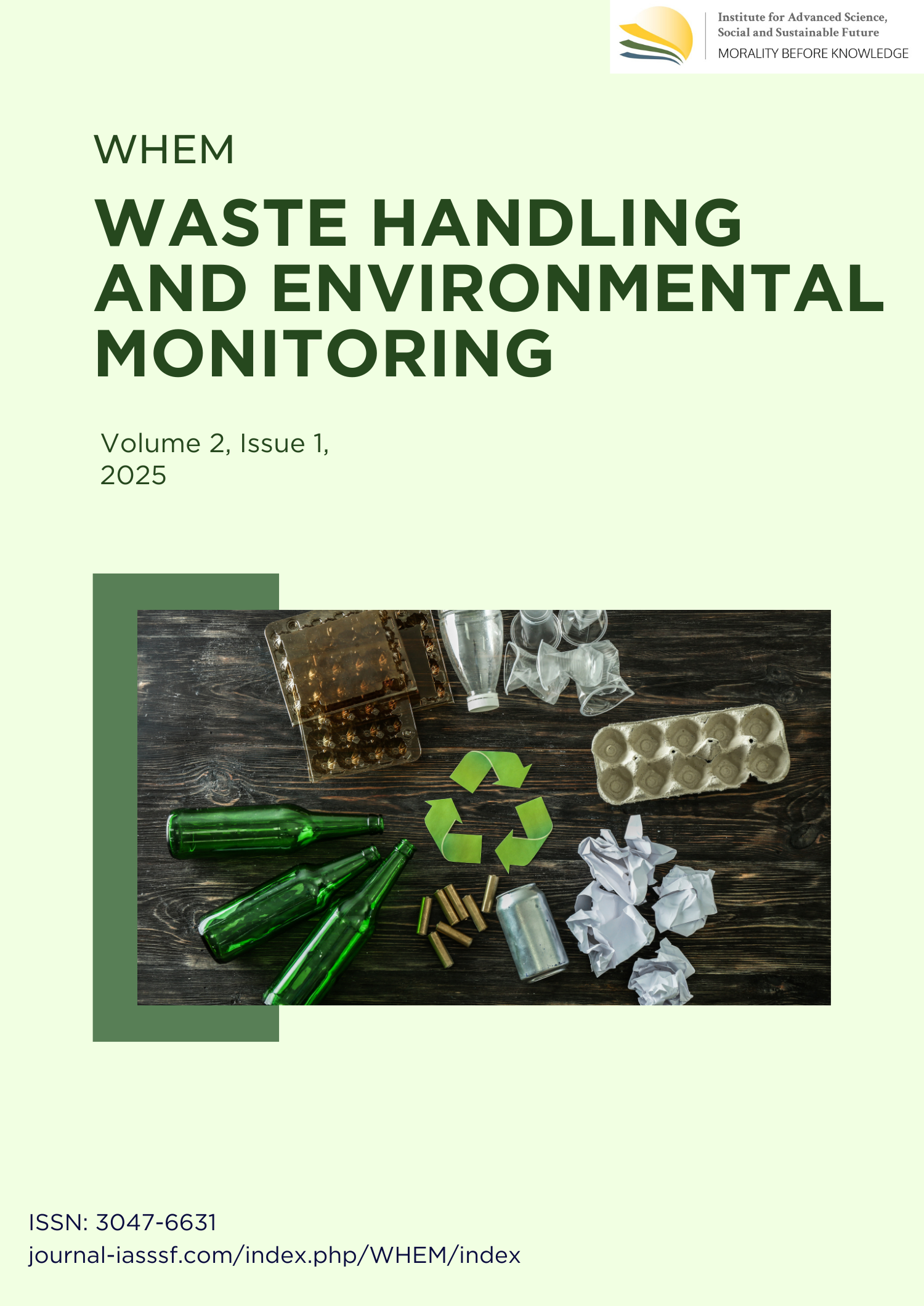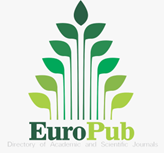Potential of nanotechnology-based nanomaterials and biochar for tofu wastewater filtration: A review on clean water sustainability
DOI:
https://doi.org/10.61511/whem.v2i1.2025.1653Keywords:
nanomaterials & biochar, tofu liquid waste filtration, clean waterAbstract
Background: Water pollution, driven by industrial activities and population growth, increasingly contaminates water sources, threatening clean water supply. Tofu wastewater, rich in organic pollutants, exacerbates this issue, highlighting the need for sustainable, effective water treatment solutions. Methods: This study uses a literature review method, analyzing journals, articles, and scientific publications to explore nanomaterials and biochar for efficient tofu wastewater treatment and improving water quality in Semarang City. Findings: The filtration system using biochar, CNT, TiO₂, and ZVI significantly reduces contaminants in water, enhancing water quality. Each material contributes uniquely, improving adsorption, photocatalysis, and overall filtration efficiency for heavy metals and organic compounds. Carbon nanotubes (CNTs), zero-valent iron (ZVI), and titanium dioxide (TiO2) exhibit high efficiency in environmental remediation, offering cost-effective, sustainable solutions despite challenges like toxicity and mobility. The study demonstrates the potential of nanomaterials like CNTs, ZVI, and TiO2 for enhanced environmental remediation, particularly in wastewater treatment. Their synergistic use improves contaminant removal, offering sustainable solutions with significant efficiency gains. Conclusion: In conclusion, integrating nanotechnology and biochar for tofu wastewater treatment presents a sustainable, scalable solution that advances both environmental remediation and technological innovation, aligning with SDGs and enhancing water quality management efforts. Novelty/Originality of this article: The novelty lies in combining nanomaterials and biochar for efficient tofu wastewater treatment, enhancing filtration and sustainability in water quality management.
References
Ajien, A., Idris, J., Md Sofwan, N., Husen, R., & Seli, H. (2023). Coconut shell and husk biochar: A review of production and activation technology, economic, financial aspect and application. Waste Management and Research, 41(1), 37–51. https://doi.org/10.1177/0734242X221127167
Ajith, M. P., & Rajamani, P. (2021). Nanotechnology for water purification – current trends and challenges. Journal of Nanotechnology and Nanomaterials, 2(2), 88–91. https://doi.org/10.33696/nanotechnol.2.025
Annan, E., Agyei-Tuffour, B., Bensah, Y. D., Konadu, D. S., Yaya, A., Onwona-Agyeman, B., & Nyankson, E. (2018). Application of clay ceramics and nanotechnology in water treatment: A review. Cogent Engineering, 5(1), 1–35. https://doi.org/10.1080/23311916.2018.1476017
Armaković, S. J., Savanović, M. M., & Armaković, S. (2023). Titanium Dioxide as the Most Used Photocatalyst for Water Purification: An Overview. Catalysts, 13(1). https://doi.org/10.3390/catal13010026
Arora, B., & Attri, P. (2020). Carbon nanotubes (CNTs): A potential nanomaterial for water purification. Journal of Composites Science, 4(3). https://doi.org/10.3390/jcs4030135
Aqlys, S. A. S. H., & Cahyanugroho, O. H. (2024). Potensi dan efektivitas limbah cair industri tahu sebagai pupuk organik cair terhadap pertumbuhan cabai dan tomat. Journal Serambi Engineering, 9(3). https://jurnal-serambimekkah.org/index.php/jse/article/view/1928
Artiningsih, Mardiansjah, F. H., Anas, N., & Khairunisa, M. U. (2018). Kajian kinerja layanan sanitasi di Kota Semarang. Riptek, 12(2), 69–78. https://riptek.semarangkota.go.id/index.php/riptek/article/view/2
BPS. (2024). Produksi tanaman perkebunan (ribu ton). (Survei Perusahaan Perekebunan; Kementerian Pertanian, Direktorat Jenderal Perkebunan), Badan Pusat Statistik. https://www.bps.go.id/id/statistics-table/2/MTMyIzI%3D/produksi-tanaman-perkebunan.html
BPS. (2025, 6 Februari). Banyaknya desa/kelurahan menurut jenis pencemaran lingkungan hidup (Desa), 2024. Badan Pusat Statistik. https://www.bps.go.id/id/statistics-table/2/OTU5IzI%3D/banyaknya-desa-kelurahan-menurut-jenis-pencemaran-lingkungan-hidup.html
Dewantoro, W., & Sitaresmi, D. T. (2022). Potensi dan permasalahan penyediaan air bersih di Kelurahan Kariangau menggunakan root cause tree analysis. REGION: Jurnal Pembangunan Wilayah dan Perencanaan Partisipatif, 17(1), 167–180. https://doi.org/10.20961/region.v17i1.50919
El-Gohary, R. M., El-Shafai, N. M., El-Mehasseb, I. M., Ghamry, H. I., Alshahrani, M. Y., & Beltagi, A. M. (2025). Design plasmonic nanostructure of silicon dioxide and titanium dioxide loaded on a nano surface for clean water production through photocatalysis and electrochemical techniques. Materials Research Bulletin, 182(5). https://doi.org/10.1016/j.materresbull.2024.113120
Fajar, G. I. (2017). Peran nanomaterial di dalam pengolahan air. Research Gate, 12, 1–8. https://doi.org/10.5281/zenodo.1134225
Food Security Agency. (2021). Peta Ketahanan dan Kerentanan Pangan (FSVA) Kota Semarang 2021. Dinas Ketahanan Pangan Provinsi Jawa Tengah. Diakses dari https://ketahananpangan.semarangkota.go.id/v3/portal/page/konten/651/PETA-FSVA-2018
Gu, X., Guo, P., Li, Z., Xu, X., Cao, Y., Yang, G., Kuang, C., Li, X., Qing, Y., & Wu, Y. (2024). A Multifunctional Coconut Shell Biochar Modified By Titanium Dioxide For Heavy Metal Removal In Water/Soil And Tetracycline Degradation. Journal Of Cleaner Production, 482. https://doi.org/10.1016/J.Jclepro.2024.144192
Guerra, F. D., Attia, M. F., Whitehead, D. C., & Alexis, F. (2018). Nanotechnology for environmental remediation: Materials and applications. Molecules, 23(7), 1–23. https://doi.org/10.3390/molecules23071760
Irawan, A., Rahmayetty, R., Dewi, N. K., & Utami, S. (2016). Artikel_Pengaruh Aktivator Kimia pada Performasi Bioadsorben dari Karbon Tempurung Kelapa sebagai Penjernih Air Sumur. Teknika, 12(1), 103-112. https://doi.org/10.36055/tjst.v12i1.6620
Kamali, M., Appels, L., Kwon, E. E., Aminabhavi, T. M., & Dewil, R. (2021). Biochar in water and wastewater treatment - a sustainability assessment. Chemical Engineering Journal, 420, 129946. https://doi.org/10.1016/j.cej.2021.129946
Khuriyah, F. A., Nabila, A. S., Billah, M. T., & Nandini, A. (2023, November). Pengolahan limbah cair industri tahu secara aerob menggunakan lumpur aktif. In Prosiding Seminar Nasional Soebardjo Brotohardjono (Vol. 19, No. 1). https://snsb.upnjatim.ac.id/index.php/snsb/article/view/22
Li, H., Wang, X., Tan, L., Li, Q., Zhang, C., Wei, X., Wang, Q., Zheng, X., & Xu, Y. (2022). Coconut shell and its biochar as fertilizer amendment applied with organic fertilizer: Efficacy and course of actions on eliminating antibiotic resistance genes in agricultural soil. Journal of Hazardous Materials, 437. https://doi.org/10.1016/j.jhazmat.2022.129322
Liu, Y., Weng, Z., Han, B., Guo, Z., Tian, H., Tang, Y., Cai, Y., & Yang, Z. (2023). Recent studies on the comprehensive application of biochar in multiple environmental fields. Journal of Cleaner Production, 421. https://doi.org/10.1016/j.jclepro.2023.138495
Lisa, D., Syarifuddin, S., & Winarni, R. (2018). Processing of tofu industrial liquid waste with aeration and adsorption combined methods in reducing levels of bod, cod and tss in tofu industry pela mampang, mampang prapatan sub-District-South Jakarta 2018. Sanitas, 9(1), 44-50. https://doi.org/10.36525/sanitas.2018.6
Maulana, Moh. R., & Marsono, B. D. (2021). Penerapan Teknologi Membran Untuk Mengolah Limbah Cair Industri Tahu (Studi Kasus: Ukm Sari Bumi, Kabupaten Sumedang). Jurnal Teknik Its, 10(2). https://doi.org/10.12962/j23373539.v10i2.63453
Mukhopadhyay, R., Sarkar, B., Khan, E., Alessi, D. S., Biswas, J. K., Manjaiah, K. M., Eguchi, M., Wu, K. C. W., Yamauchi, Y., & Ok, Y. S. (2022). Nanomaterials for sustainable remediation of chemical contaminants in water and soil. Critical Reviews in Environmental Science and Technology, 52(15), 2611–2660. https://doi.org/10.1080/10643389.2021.1886891
Nguyen, G. T., Nguyen, U. T. T., Do, M. H., Nguyen, D. Van, Trieu, Q. A., & Bui, T. H. (2024). Effective Adsorption Of Gold From Electronic Waste By Acid Leaching Solution Using Zero-Valent Iron Microparticles Modified–Biochar. Journal Of Environmental Chemical Engineering, 12(2). https://doi.org/10.1016/J.Jece.2024.112063
Nursanti A. M. Syafira A., P. (2022). Studi Literatur: Perkembangan Nanomaterial. Berkala Fisika, 25(3), 111–121. https://ejournal.undip.ac.id/index.php/berkala_fisika/article/view/50741
Pradana, A. (2023). Transformasi Sistem Pangan Berkelanjutan di Kota Semarang melalui Policy Brief. Jurnal Riptek, 17(1), 61–70. https://doi.org/10.35475/riptek.v17i1.197
Prasetiyo, K. W. (2020). Aplikasi Nanoteknologi dalam Industri Hasil Hutan (Application Of Nanotechnology In Forest Products Industry). Jurnal Akar, 9(1), 13–24. https://doi.org/10.36985/jar.v9i1.189
Ramadhan, F. (2022). Analisis Kebutuhan Air Minum Kelurahan Sungai Sengkuang Yang Bersumber Dari Spam Ikk Sungai Sengkuang. Jurnal Teknologi Infrastruktur, 1(2), 47-55. https://jurnal.upb.ac.id/index.php/ft/article/view/337
Reihanifar, M., Takallou, A., Taheri, M., Lonbar, A. G., Ahmadi, M., & Sharifi, A. (2024). Nanotechnology advancements in groundwater remediation: A comprehensive analysis of current research and future prospects. Groundwater for Sustainable Development, 27, 101330. https://doi.org/10.1016/j.gsd.2024.101330
Sajid, M., Asif, M., Baig, N., Kabeer, M., Ihsanullah, I., & Mohammad, A. W. (2022). Carbon nanotubes-based adsorbents: Properties, functionalization, interaction mechanisms, and applications in water purification. In Journal of Water Process Engineering, 47. https://doi.org/10.1016/j.jwpe.2022.102815
Simanjuntak, S., Zai, E. O., & Tampubolon, M. H. (2021). Analisa Kebutuhan Air Bersih Di Kota Medan Sumatera Utara. In Jurnal Visi Eksakta (Jvieks), 2(2). https://ejournal.uhn.ac.id/index.php/eksakta/186
Singh, K. K., Singh, A., & Rai, S. (2021). A study on nanomaterials for water purification. Materials Today: Proceedings, 51, 1157–1163. https://doi.org/10.1016/j.matpr.2021.07.116
Wibowo, Y. G., Ramadan, B. S., & Andriansyah, M. (2019). Simple Technology to Convert Coconut Shell Waste into Biochar; A Green Leap Towards Achieving Environmental Sustainability. Jurnal Presipitasi : Media Komunikasi Dan Pengembangan Teknik Lingkungan, 16(2), 58. https://doi.org/10.14710/presipitasi.v16i2.58-64
Yadav, N., Singh, S., Saini, O., & Srivastava, S. (2022). Technological advancement in the remediation of heavy metals employing engineered nanoparticles: A step towards cleaner water process. Environmental Nanotechnology, Monitoring and Management, 18(8). https://doi.org/10.1016/j.enmm.2022.100757
Yang, X., Zhao, R., Zhan, H., Zhao, H., Duan, Y., & Shen, Z. (2024). Modified Titanium dioxide-based photocatalysts for water treatment: Mini review. Environmental Functional Materials, 3(1), 1-12. https://doi.org/10.1016/j.efmat.2024.07.002
Yu, P., Tan, J., Wang, Z., Zhang, C., Wang, Q., Zhu, K., Peng, C., Xiao, X., & Huang, W. (2024). Enhanced electron transfer pathway of zero-valent iron particles immobilized on coconut shell derived carbon for prolonged Cr(VI) removal. Colloids and Surfaces A: Physicochemical and Engineering Aspects, 682. https://doi.org/10.1016/j.colsurfa.2023.132863
Downloads
Published
How to Cite
Issue
Section
Citation Check
License
Copyright (c) 2025 Dionezra Bagus Imanuel, Faatin Nisriinaa Zain, Belvannia Levina Celesta, Mochammad Choiril Muna

This work is licensed under a Creative Commons Attribution 4.0 International License.














